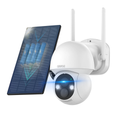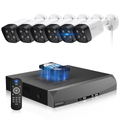The Indispensable Role of Lenses in Surveillance
Lenses, often referred to as the eyes of cameras, play a pivotal and often underestimated role in the world of surveillance. OHWOAI, a frontrunner in the surveillance industry, is keen to emphasize the vital significance of lenses in our quest to provide unparalleled security solutions. In this discourse, we delve into the pivotal aspects of lenses, exploring their multifaceted impact on capturing precise and detailed images across diverse monitoring environments.
**1. Critical Lens Parameters**
**Focal Length (f):** At the heart of lens dynamics lies the focal length, which signifies the distance between the lens and the image sensor. This parameter holds the key to magnification, influencing the size of the captured image. In scenarios where a distant object is involved, magnification can be approximated using the formula: Magnification ≈ Focal Length / Object Distance. Augmenting the focal length amplifies magnification, pulling distant subjects closer and highlighting intricate details. Conversely, reducing the focal length broadens the field of view, encompassing a larger scene within the image.
**Field of View (FOV):** In the practical application of lenses, the horizontal field of view holds immense significance. As the focal length (f) increases, the field of view narrows, resulting in a more concentrated image on the image sensor. In contrast, a smaller focal length expands the field of view, capturing a broader scene within the image sensor's scope.
**Aperture:** The aperture, nestled at the lens's rear, serves as a gateway for light to enter. A wider aperture allows an increased volume of light to pass through, rendering sharper images. Conversely, a narrower aperture restricts light and may result in diminished image clarity. The aperture is often denoted by the F-number (F), where F = Focal Length (f) / Aperture Diameter. A lower F-number signifies a larger aperture, facilitating the passage of more light to the CCD sensor, ultimately enhancing lens quality.
**2. Lens Categorization**
Lenses can be categorized based on two fundamental factors:
**Field of View (FOV) Classification:**
Diverse surveillance scenarios necessitate varying field of view angles. For instance, indoor surveillance mandates clear images with a wide field of view, demanding the application of wide-angle lenses. On the other hand, outdoor environments like parking lots require lenses that not only capture the overall scene but also focus on specific vehicles' finer details. Border security and coastal surveillance demand lenses capable of capturing ultra-distant images, catering to expansive monitoring needs.
**Aperture Classification:**
A secondary categorization stems from aperture sizes. Lenses with larger apertures (lower F-numbers) enable more light entry, ideal for low-light conditions where image clarity is paramount. Conversely, lenses with smaller apertures (higher F-numbers) control light intensity, advantageous when dealing with excessive light or glare.
In summation, OHWOAI's relentless pursuit of unrivaled surveillance excellence encompasses a comprehensive grasp of lenses' role. The intricate interplay of focal length, field of view, and aperture defines our cameras' prowess in delivering unparalleled performance across diverse contexts. From compact security camera systems with audio recording to comprehensive home security systems with Wi-Fi cameras, wireless outdoor camera systems, and advanced wireless solutions equipped with night vision and audio, OHWOAI consistently integrates cutting-edge lens technology. By choosing OHWOAI, you empower your security infrastructure with the assurance that every captured image surpasses expectations, ensuring an unyielding balance between surveillance accuracy and image quality.
Sample Block Quote
Nam tempus turpis at metus scelerisque placerat nulla deumantos sollicitudin delos felis. Pellentesque diam dolor an elementum et lobortis at mollis ut risus. Curabitur semper sagittis mino de condimentum.










